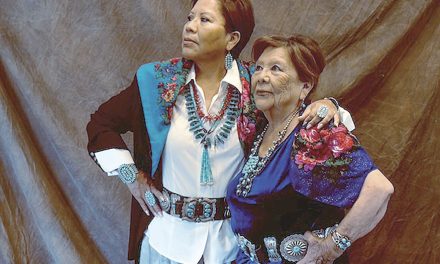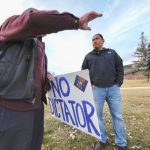
Letters | We are still here
We are still here
Editor,
This letter responds to David Siegel’s letter in last week’s Navajo Times. I do not write to comment on the Department of the Interior’s decision on Chaco Canyon or the impact of that decision on anyone.
I write to speak on the incompleteness of Mr. Siegel’s story, a story based on the flawed reasoning of Western Thought.
The greatest fallacy of Western Thought is the attempt to dichotomize/separate the life realities of the physical and spiritual. Seems Mr. Siegel as an archeologist would have had many opportunities to hear the Indigenous worldview. As a man of science, he has apparently dismissed the validity of Indigenous belief which includes our oral histories that connect us to our ancient past.
Originally the fours colors of humanity were given fundamental understanding to honor the physical and the spiritual for prosperity of life. It is the wandering white tribe that largely abandoned those original teachings, abusing the earth to great harm and putting the future of humanity in exigent peril.
The requirement for empirical evidence by Western Thought with its science and technology are one-sided, as they do not account for the spiritual reality in the scientific equation. The physical and spiritual paradigms are inseparable. Only in death is there a separation.
It is nonsensical to argue that Pueblo people have no proof to claim their lineage to the ancestral people of Chaco Canyon. It is as nonsensical as an archeologist digging up Indian bones and saying that it is somehow different from someone excavating a white cemetery.
These are our histories; we belong to these lands and these lands belong to us in perpetuity. We have no need to prove our connection to our ancestors or justify our God-given rights and authority to belong here. You want proof, we are still here, that is the proof.
Chili Yazzie
Shiprock
Letter writer’s words, claims are incorrect, disrespectful
Editor,
We use this space to respond, in part, to a recent Letter to the Editor that appeared in the Navajo Times. The writer, David Siegel, is apparently a former archaeologist, but many of the statements made suggest very little acquaintance with Pueblo oral history or anthropological and archaeological knowledge of the American Southwest.
The overall point of the Navajo Times letter was to object to Interior Secretary Deb Haaland’s removal of 340,000 acres of Federal lands managed by the Bureau of Land Management (BLM) from oil-and-gas development in a 10-mile zone surrounding Chaco Culture National Historical Park. Reading between the lines, we might infer that his primary interest is keeping as many lands open to oil-and-gas drilling as possible, despite the overwhelming support in the Greater Chaco region, in New Mexico, and across the West to protect the amazing and irreplaceable sites, traditional places, and cultural landscapes of Chaco Canyon.
Most egregious, perhaps, is the claim that “the US Department of the Interior has stolen Navajo property rights.” As reported in multiple media sources for nearly two years, and as discussed in multiple public hearings held by BLM on this issue, the mineral withdrawal has absolutely no effect on any other non-Federal mineral rights in the 10-mile protection zone. The claim that Navajo allottee property rights will be affected is patently false.
To try to make the case for not protecting cultural resources in the 10-mile protection zone, the author disparages contemporary Pueblo Tribes and people, making the ridiculous claim that there is no ancestral connection between Pueblo people and the amazing sites in Chaco Canyon. The absurdity of this claim is appalling.
Well-documented Pueblo oral history provides an unbroken link from the present to the Chacoan past, and even extends thousands of years prior. In addition, more than 160 years of anthropological study of Chaco Canyon provides a clear and unambiguous connection from ancient Chacoan society to historic and modern Pueblo communities of New Mexico and Arizona.
The case for protecting the 10-mile zone around Chaco Canyon has been made many times and can be summarized here. A recent review of archaeological and historical data reveals 4,200 known cultural sites in the 10-mile protection zone. These places were created by diverse groups – including Paleoindian, Archaic, Pueblo, Navajo, Jicarilla Apache, and others – in time periods from about 10,000 BCE to the present.
Because less than 20 percent of the area enclosed by the 10-mile zone has been archaeologically or culturally surveyed, the actual site count is undoubtedly much higher. In addition, the protection zone contains at least 17 communities or site clusters that date to the Archaic, Pueblo, and Navajo time periods.
One of these communities, known as Pierre’s, has been the focus of archaeological and ethnographic research; most have not. All of these places and landscapes contain significant cultural values that merit strong protection.
As an enrolled member of the Navajo Nation, I (Skylar Begay) do not believe that David Siegel, as a retired archaeologist and as a non-member of either the Navajo Nation or any Pueblo Tribe, should have any say in the relationship between sovereign Tribal Nations, nor should he be making recommendations to the Navajo Nation and its citizen-members regarding the exercise of Tribal sovereignty.
The misinformation and erroneous comments put forth by his letter to the Navajo Times are reminiscent of historical strategies used by colonizing powers to divide Indigenous Peoples against one other. Therefore, I do not believe his words should hold any weight among Navajos nor our Pueblo relatives, not least because they are blatantly incorrect and so disrespectfully stated.
Skylar Begay
Fort Defiance/Window Rock
Editor’s note: Skylar Begay is Diné, Mandan and Hidatsa. He is the director of tribal collaboration in outreach and advocacy for Archaeology Southwest in Tucson.
Invite to tour Counselor area extended to elected Navajo leaders
Editor,
Yá’át’ééh Honorable Navajo Nation President Nygren and Vice President Montoya.
We are writing to provide the Office of the President and Vice President with background information and context regarding the federal government’s recent passing of Public Land Order No. 7923, as well as invite you to tour oil and gas facilities located in the Eastern Diné communities of the Greater Chaco region, to view firsthand the frontline impacts from oil and gas pollution.
We also would like to emphasize that there are Eastern Diné community members and allottees who have raised concerns about oil and gas pollution and environmental justice issues in the Greater Chaco region in Northwest New Mexico, across Navajo Nation trust and checkerboard lands.
These voices have been active for years, speaking and testifying before federal, state, and tribal committees and agencies, as well as documenting their complaints in local Chapter resolutions, health assessments, and lawsuits.
Recently, the Honorable Representative Teresa Leger Fernandez invited Eastern Navajo residents to submit written testimony regarding House Resolution 4374. The statements powerfully illustrate the real life impacts that Navajo constituents experience from oil and gas/fracking operations.
Concerns range from heavy truck traffic to disintegrating dirt roads to the odor of propane in the air and these are but a few of the detrimental impacts. We are including several of those testimonies along with this letter.
For the past two years, Kendra Pinto, a Diné who is a certified thermographer with Earthworks, has conducted multiple investigations into oil & gas pollution harms in the Four Corners region. With every trip, Kendra has found harmful methane and volatile organic compounds (VOC) emissions, generally due to equipment failures or malfunctions, using the FLIR GF320, the same Optical Gas Imaging camera the oil industry and regulatory agencies use.
Kendra has filed environmental complaints with the proper regulatory agencies in the Checkerboard region, including the New Mexico Environmental Department, the State Land Office, and the Navajo Nation Environmental Protection Agency, when the severity of the findings warranted reporting.
Due to the isolated area and limited services, it is unsurprising these complaints rarely get a response. The result of this low prioritization of Indigenous communities is systematic and has serious consequences.
The areas of Nageezi and Counselor do not have a fire department, a police department, an Urgent Care center, or any proper medical emergency services. These are basic services that are not immediately available within the extraction zones. When the WPX explosion happened in 2016, it took thirty minutes for the first fire truck to respond. Fortunately, no serious injuries were reported. However, had the case been different, how would the Navajo Nation have responded to that emergency situation?
What are solutions that the Navajo Nation is creating to ensure that their tribal members do not continue to experience oil explosions and large-scale produced water spills – especially when the risks of oil & gas extraction are so well documented?
Since 2018, over 50 complaints regarding methane and VOC emissions have been filed with the New Mexico Environment Department. Most of these complaints have gone unanswered. The accountability from the oil companies when they are polluting the air is minimal, yet the dangers are astronomical.
Air testing in the Chaco region has shown elevated levels of hazardous gas; the presence of highly toxic and deadly hydrogen sulfide was documented near the Lybrook Elementary School. Very few studies have been done to test the air, soil, and water quality; a vital responsibility that the Nation should absolutely consider funding.
A couple of years before 2018, there was a visit to the Council Chamber to present a packet of information on hydraulic fracturing. It was passed to the Delegates in attendance, while four Dine women and one Dine man gave testimony on how their lives are impacted by fracking. An Eastern Agency Council Delegate responded by remarking that the information we provided was not of importance, and alluded that it had nothing to do with Navajo Nation.
We assure you, the process to extract oil and gas is the same process used outside the reservation. There are countless studies that have proven that living near fracking is extremely dangerous. The 2022 report, “Compendium of Scientific, Medical, and Media Findings
Demonstrating Risks and Harms of Fracking and Associated Gas and Oil Infrastructure (8th Ed),” by the Concerned Health Professionals of New York and Physicians for Social Responsibility, fully references a compilation of evidence from all over the world, outlining the risks and harms of fracking.
However, an in-depth health impact study still needs to be done in the Eastern Agency, where continued oil and gas well drilling and operations are taking place, further exposing the population to health harms.
As Navajo Nation constituents, our concerns for a safe and uncontaminated environment benefits all of our communities and our collective physical, cultural and spiritual health. Remaining connected to our homelands is a huge part of why we do this work. The continuation of land leasing to oil and gas companies does not benefit our nation as a whole, and it especially impacts those living near extractive operations.
How we treat the land becomes a reflection of our commitment to future generations. Interior Secretary Deb Haaland’s decision to withdraw land from the federal oil and gas leasing program was the right one for our people now, and those generations of Diné to come.
In the spirit of continued information sharing and dialogue, we would like to invite you on a tour of the Counselor area near the 10-mile buffer to see, hear and understand these protections are essential. We believe that seeing is believing – there is no substitute for seeing the pollution and listening to the stories of harm to the land, air, water and people.
We are hopeful you will join us and offer to arrange a tour at your convenience this August or September. We look forward to your prompt response.
Kendra Pinto
Four Corners Indigenous Community Field Advocate
Earthworks
Nageezi, N.M.
Robyn Jackson
Executive Director Diné C.A.R.E.
Wheatfields, Ariz.








 Highway 264,
Highway 264, I-40, WB @ Winslow
I-40, WB @ Winslow